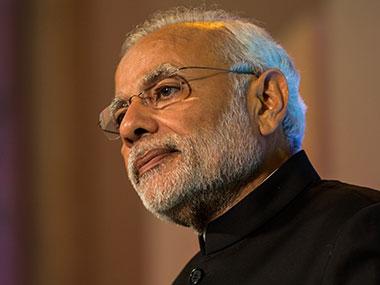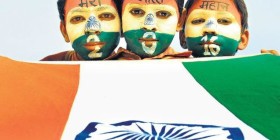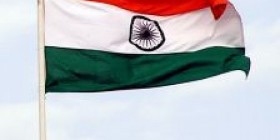Now that Narendra Modi has completed two years in office, there are two ways of judging the performance of his government. One is to analyse his government’s claims. The other way is to examine the failures his opponents and critics point out. Ideally, of course, there should be a convergence of these two approaches, and that too on the fronts of ‘development’ and ‘governance’, the two issues that Modi had highlighted to be his focus areas. However, one does not come across many such assessments.
In a country like India, it is logical to expect that economic issues in general and that of jobs, employment and income in particular should dominate a country’s polity. Interestingly, however, that is not happening either in India under Modi or in advanced industrial democracies in the West. Political scientists have found out that unlike in the past when democratic governments, for their survival, adopted such redistributive policies as progressive taxation, social insurance and expansive welfare measures, these days non-economic issues such as environmentalism, intellectual freedom, gender equality, identity politics, nationalism and immigration are determining the fates of governments.
As Professor Ronald Inglehart, founding president of World Values Survey, has explained, with higher levels of economic and physical security of the people in general (in my opinion, it is particularly true of our political leaders and elites), there is now what is called the “postmaterialist mindset” with greater emphasis on autonomy and self-expression that dominates democratic polities. As a result, we now have “a decline in class politics” and “a rise in political polarisation based on noneconomic issues”. It is not that the classic economic issues have disappeared during elections. But their relative importance has declined and noneconomic issues have become more prominent. “The electorate had (has) shifted from class-based polarisation toward value-based polarisation,” argues Inglehart.
This, perhaps, explains why during two years of Modi as Prime Minister, we have seen most of the criticisms against him being non-economic in nature. We have seen fewer discussions on Modi’s pet schemes like Make in India, Skill India, Cleaning of Ganga and the Kisan-oriented budget. On the other hand, the debates over Modi as Prime Minister have been on his “scant regards for democracy”, “authoritarian style of functioning”, “growing communalisation of the polity”, “curbing dissent” and so on.
There have been systematic attempts through these debates to polarise the polity; those supporting Modi are called “bhakts” by Modi’s critics and those demonising Modi have been labelled as “anti-nationals” by Modi’s supporters. And it so happens that this battle has been quite unequal, with Modi’s critics, who dominate India’s intellectual shape, outnumbering those who have supported the Prime Minister.
In my considered view, most of the political attacks (not on economic and development issues) have been really unfair. Let me explain only one of them. Are we Indians really heading for an Emergency-like situation that habitual Modi-bashers are predicting? They say that Modi is behaving like late Indira Gandhi who gained the authority to rule by decree, allowing civil liberties to be curbed.
Prof. Milan W. Svolik of University of Illinois has examined a fundamental problem of politics in authoritarian regimes and concluded that the dictator and the ruling coalition must share power and govern in an environment where political influence must be backed by a credible threat of violence. In his model of authoritarian politics, power sharing is complicated by this conflict of interest: by exploiting his position, the dictator may acquire more power at the expense of the ruling coalition, which may attempt to deter such opportunism by threatening to stage a coup (revolt). Two power-sharing regimes – contested and established dictatorships – may emerge as a result of strategic behaviour by the dictator and the ruling coalition. This theory accounts for the large variation in the duration of dictators’ tenures and the concentration of power in dictatorships over time.
Svolik has studied 316 authoritarian leaders of the world who were in power for various lengths of time between 1945 and 2002. Some of them got out because of constitutional means such as elections (death or a hereditary succession). Some were dethroned from power through nonconstitutional means – assassinations, popular uprisings and foreign interventions. But 205 dictators-more than two-third-were removed by government insiders, such as other government members or members of the military or security forces.
Svolik’s basic point is that for a leader to succeed as an authoritarian, he or she must have perfect equations with governing elites, ranging from ministerial colleagues to party cadres to bureaucrats to military leaders to intellectuals. Political institutions in dictatorships, such as governing councils, legislatures, or parties, may therefore function to allow members of the governing authoritarian elite to reassure each other that none of them is trying to acquire more power at others’ expense. And having perfect equations depends on the extent to which the leader shares his or power with these governing elites.
In other words, politics ‘among’ the governing authoritarian elites is the key to determining the probability of the phenomenon of dictatorship and its subsequent durability. An ‘established’ dictator keeps this politics totally under his or control and hence remains in power for long (Fidel Castro in Cuba or the Communist oligarchs in China, for instance). The ‘contested’ dictators, on the other hand, are unable to manage the sharing of power and get dethroned in the process – either military coups or judicial verdicts (we see this happening in Pakistan from time to time).
Technically speaking, Indira Gandhi had revoked Emergency and had gone for polls in 1977. There is not enough literature to find out as to why she revoked it. Was it due to the fact that she was finding it difficult to manage the sharing of power with the governing elites? Was she apprehending problems from the military? Well, I do not know the answers. But I am quite convinced that Modi will not be able to manage the sharing of power either (he does not have total loyalty of his key cabinet colleagues and top leaders in the party, let alone the support of the bosses in RSS) and therefore it is next to impossible for him to become a dictator. In fact, unlike Indira Gandhi, Modi does not have the luxury of keeping two other important sections of the governing elites with him on his side.
It may be noted that for any successful dictator, it is absolutely vital to keep the judiciary on its side. In Pakistan therefore we notice that its judiciary has virtually endorsed every spell of dictatorship under what it says “the doctrine of necessity” (It was only after Pervez Musharraf fought with the then Chief Justice of the country that his decline began). Similarly, when Indira Gandhi imposed Emergency, she had a set of “committed judges” in the Supreme Court. It is impossible that Modi is going to have his henchmen occupying the positions in the Indian Supreme Court.
Secondly, all told, Indira Gandhi, thanks to her ostensible Left-inclinations, enjoyed the overwhelming support of the Indian intellectual elite, dominated by the Leftists in the Nehruvian fold. Besides, it must be noted that the Indian press, though asked to bend, literally crawled during Emergency. And that was understandable because the survival of most of the newspapers (there was no television) depended on government advertisements. In the “command and control” (closed) economy that Indira Gandhi had promoted, there were not many vibrant private industries who could have sustained a free media then.
But today, the situation is different. Most of the leading and successful media houses are not dependent on the government; in fact, their owners and promoters happen to be among the country’s richest. So “an authoritarian Modi” cannot dream of having a puppet media in India today. And no dictator anywhere in the world can sustain power in the absence of a puppet media.
Ironically, most of Modi’s critics who accuse the Prime Minister of trampling dissent or civil rights happen to be those secularists and leftists who have tolerated more incidents of banning and restrictions on ideas than anyone else. In fact, they are more intolerant of others’ views. They can rewrite and reinterpret history books, as they did under Congress regimes, particularly under education ministers like Nurul Hasan and Arjun Singh, but deny the same right to rightists as they did under the former prime minister Atal Behari Vajpayee’s regime and do now under that of Narendra Modi.
Unfortunately for Modi, India’s perception-makers are overwhelmingly dominated by academicians, artists, journalists and contributors who are moulded in what is said to be the Nehruvian framework or establishment– ‘Left/Liberal/Secular’. No wonder they are deliberately building up perceptions that nothing is happening in India and that the country is literally burning along ethnic and religious fault-lines. In the process, the real issues on the front of governance have taken a back seat. And paradoxically, it is suiting Modi as his ‘governance’ on the front of ‘development’ has not come under rigorous scrutiny. In this sense, Modi’s critics are his best friends.






Leave a reply